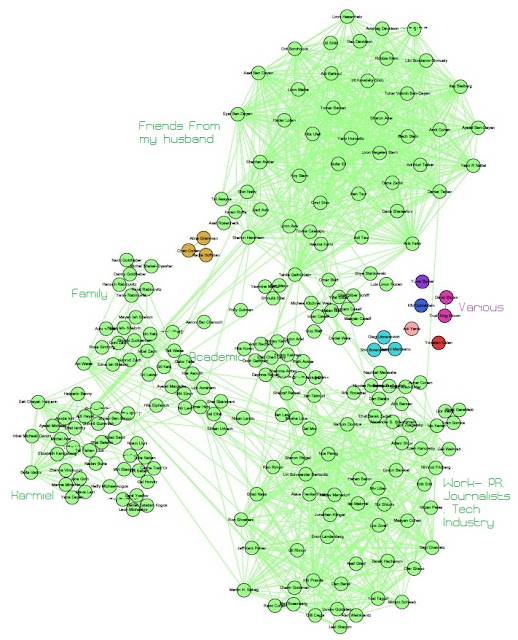Nowadays, I'm learning SNA (Social Network Analysis) in Coursera with Prof. Lada Adamic (University of Michigan), and it's a fascinating course!
How is it related to my research?
Well, in many ways. For example, Adamic & Glance's important research from 2005: The Political Blogosphere and the 2004 U.S. Election: Divided They Blog. Or more recent research: Learning Analytics for Learning Blogospheres- Pham, Derntl, Cao & Klamma (2012).
Here's the first assignment (of the SNA course): My Facebook Network, using Gephi - an exciting open-source network visualization platform.
You can see the 'Giant Component' (and other nodes in my network, which are not connected to the others).
And here you can see the centrality measure of 'betweenness':
LinkedIn created the basic map automatically (LinkedInLabs- InMaps):
For further exploration, I recommend the following items:
Video: Social Network Analysis- The Basics from 'GalaxyAdvisors', with basic vocabulary, professional associations, and interesting references.
Also, for extensive basic info: social network analysis presentation from Guillaume Ereteo.
Video from TED: Nicholas Christakis and his spectacular speech on The hidden influence of social networks. This video summarizes his & James Fowler's book: 'The Surprising Power of Our Social Networks and How They Shape Our Lives - How Your Friends' Friends' Friends Affect Everything You Feel, Think, and Do.'
I think it is a perfect example of the practical use of SNA.
Video from TEDxRiga: Valdis Krebs's dialog about Ending up on the Wrong Side of the Tracks. Additionally, I think this short presentation, by Alexander Semeonov, emphasizes Krebs's point: Social network analysis of hashtag usage during protest meetings.
David Easley & Jon Kleinberg placed their SNA Textbook online for free download: Networks, Crowds, and Markets: Reasoning About A Highly Connected World. I think it's an important book due to its extensive materials and its interdisciplinary approach to understanding networks.
That's it for now. For closure, here's a nice guy to follow on Pinterest :-)




